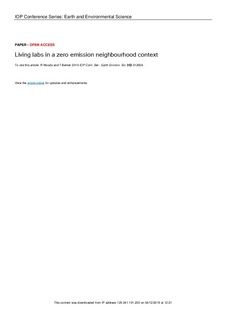| dc.contributor.author | Woods, Ruth | |
| dc.contributor.author | Berker, Thomas | |
| dc.date.accessioned | 2019-12-04T12:22:48Z | |
| dc.date.available | 2019-12-04T12:22:48Z | |
| dc.date.created | 2019-11-18T10:38:26Z | |
| dc.date.issued | 2019 | |
| dc.identifier.issn | 1755-1307 | |
| dc.identifier.uri | http://hdl.handle.net/11250/2631755 | |
| dc.description.abstract | The Research Centre for Zero Emission Neighbourhoods in Smart cities has established a concept for living labs. Central to the concept is an experimental format that offers some control over the social and physical environment, as well as opportunities to observe and engage during a limited period. According to Bulkeley et al. 2018, an experiment offers a means to make sense of the present whilst also providing a vision of the future [1]. The paper asks, what are the implications for users when engaging with experiments and presents results from a ZEN living lab experiment that took place at Campus Evenstad in Hedmark, Norway. Technical management at Evenstad proposed the experiment, they wanted to test if it was possible to reduce campus energy consumption and the starting point was the old administration building, which has the highest energy consumption on campus. The energy use reduction was to be achieved by turning off the building’s heating and ventilation systems during a limited four-week period. This took place in July 2018, when the building users were expected to be on holiday or doing fieldwork. A workshop to anchor the experiment among building users took place a month before the experiment started. During the workshop challenges associated with the experiment and with the building, for users, became apparent. However, building users agreed to participation in the experiment because they saw it as an opportunity to highlight what they understood as necessary changes to the building. The experiment achieved the energy saving potential that the building managers envisioned, but the results for the building users are less tangible. From a pragmatist approach, living labs and their experiments are about providing solutions, but the Evenstad example highlights the challenge of providing tangible solutions and how we engage users with more intangible future solutions. We discuss therefore the limitations and potentials associated with the experimental format. Moving beyond demonstrating what a sustainable future should look like and include [1p.1], and instead noting opportunities for the translation of societal learning into concrete actions that serve the user groups engaged as well as demonstrating, the potential to influence wider sustainable transitions. | nb_NO |
| dc.description.abstract | Living labs in a zero emission neighbourhood context | nb_NO |
| dc.language.iso | eng | nb_NO |
| dc.publisher | IOP Publishing | nb_NO |
| dc.rights | Navngivelse 4.0 Internasjonal | * |
| dc.rights.uri | http://creativecommons.org/licenses/by/4.0/deed.no | * |
| dc.title | Living labs in a zero emission neighbourhood context | nb_NO |
| dc.type | Journal article | nb_NO |
| dc.type | Peer reviewed | nb_NO |
| dc.description.version | publishedVersion | nb_NO |
| dc.source.volume | 352 | nb_NO |
| dc.source.journal | IOP Conference Series: Earth and Environmental Science (EES) | nb_NO |
| dc.source.issue | 1 | nb_NO |
| dc.identifier.doi | 10.1088/1755-1315/352/1/012004 | |
| dc.identifier.cristin | 1748602 | |
| dc.relation.project | Norges forskningsråd: 257660 | nb_NO |
| dc.description.localcode | Content from this work may be used under the terms of theCreative Commons Attribution 3.0 licence. Any further distribution of this work must maintain attribution to the author(s) and the title of the work, journal citation and DOI. Published under licence by IOP Publishing Ltd | nb_NO |
| cristin.unitcode | 194,62,40,0 | |
| cristin.unitname | Institutt for tverrfaglige kulturstudier | |
| cristin.ispublished | true | |
| cristin.fulltext | postprint | |
| cristin.qualitycode | 1 | |

